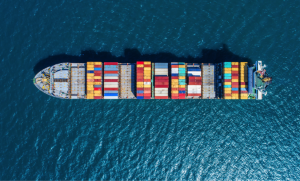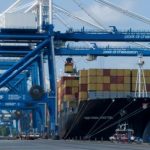Falling Freight Rates & 2019 Transpacific Shipping Outlook
 International shipping spot rates are, not surprisingly, falling at the moment. But they have been falling massively.
International shipping spot rates are, not surprisingly, falling at the moment. But they have been falling massively.
Freight rate pricing tends to fall after the Chinese New Year as demand is typically low this time of year. Right now, demand is even lower than normal because of shippers moving up imports to beat tariff increase deadlines from the U.S., China trade war.
After the prolonged peak season, because of all that front-loading of imports, freight rates have been sliding down with Mike Wackett reporting in the Loadstar that spot rates from Asia to the U.S. West Coast fell (USWC) 6% per FEU (40′ equivalent unit) last week, continuing a trend that brings those rates to 51% lower than their November peak.
Asia to U.S. East Coast (USEC) rates fell 6% last week for a total of a 39% decrease from the November peak, according to Wackett. His data source is the Shanghai Containerized Freight Index (SCFI).
Despite these massive drops, freight rates still aren’t as low as they were this time last year, according to Wackett’s article where he reported numbers that would represent a little under 18% and 15% per FEU increases for Asia to USWC and Asia to USEC shipments, respectively, over last year.
Higher freight rates over this time last year can mainly be attributed to better, more disciplined capacity management from carriers than they have pulled off in the past.
Still, the current falling freight rates make this a great time for U.S. businesspeople to import from China, especially with the latest round of tariff increases on Chinese goods postponed during trade talks.
The spot rate market performance tends to play a part in carriers’ annual contract negotiations with the big shippers, like your Wal-Marts, whose large quantity of imports garners them their own freight rates outside of the spot market.
In international shipping, these big companies are known as BCOs, which stands for Beneficial Cargo Owners.
According to Wackett’s article, current falling freight rates are making it difficult for carriers to land the kind of contracts they want with the BCOs.
The softness in the market … has come at the worst possible time for carriers serving the [transpacific] route.
At last week’s TPM conference in Long Beach, they were anxious to court their BCO customers and sign them up to new contracts, commencing 1 May.
However, aspirations of 20% uplifts in new contracts had to be tempered considerably, and The Loadstar was told that some carriers were content to keep the status quo on freight rates as long as they could get agreement to their new BAF formulae.
 BAF stands for Bunker Adjustment Factor, and is going to play a big factor in shipping costs leading into next year when the new International Maritime Organization’s (IMO) cleaner fuel mandate goes into effect.
BAF stands for Bunker Adjustment Factor, and is going to play a big factor in shipping costs leading into next year when the new International Maritime Organization’s (IMO) cleaner fuel mandate goes into effect.
The IMO mandate puts a sulfur cap of 0.5% on the fuel of cargo ships starting in 2020. The cost of meeting this mandate is significant and the biggest problem the international shipping industry faces in 2o19.
BAFs will be used to try to recoup some of the higher fuel costs carriers are facing.
If carriers cannot secure better rates in their BCO contracts while facing those increased costs from cleaner fuel upgrades, it’s guaranteed they will do everything in their power to push pricing up in the spot rate market where small to medium shippers get their freight rates.
Of course, carriers don’t always succeed in such endeavors, but their recent capacity discipline does bode well for future efforts.
Freight rates are always volatile, but this will be a particularly interesting year to keep an eye on them.




